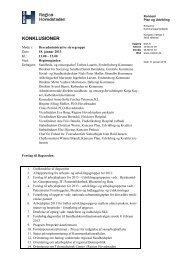Territorial Review Copenhagen - Region Hovedstaden
Territorial Review Copenhagen - Region Hovedstaden
Territorial Review Copenhagen - Region Hovedstaden
Create successful ePaper yourself
Turn your PDF publications into a flip-book with our unique Google optimized e-Paper software.
64<br />
education is almost 66% – compared to less than 30% for persons of Danish<br />
origin. Family background partly explains the dropout rate in academic<br />
upper secondary education, but not in vocational education.<br />
Shortage of highly skilled labour<br />
Unemployment in <strong>Copenhagen</strong> is very low, although the figures conceal<br />
some unused potential. The unemployment rate in <strong>Copenhagen</strong> stood at 5%<br />
in 2007, the lowest rate in more than three decades, and continued to<br />
decrease well into 2008, reaching a monthly unemployment rate of around<br />
2% in the summer of 2008. Few metropolitan areas in the OECD have lower<br />
unemployment rates. The combination of low unemployment rates and high<br />
participation rates suggests that the labour force is well-utilised. The<br />
participation rate in <strong>Copenhagen</strong> was almost 80% in 2005; the seventhhighest<br />
participation rate among 78 metropolitan areas in the OECD. High<br />
participation rates can be explained by increased female labour participation<br />
rates, in part supported by government policies that include child care<br />
facilities and the right to maternity leave until children reach 9 years old. 17<br />
The female participation rate in <strong>Copenhagen</strong> in 2005 was ranked 2 nd out of<br />
39 metropolitan areas in the OECD. Certain demographic groups could,<br />
however, be better used, in particular elderly people, some of those<br />
receiving disability payments and immigrants (see also section below).<br />
Labour market shortages in Denmark have made hiring more difficult in<br />
the last few years. Hiring problems are reported in certain health<br />
professions, the welfare sector, hotels and restaurants and graphic design. A<br />
further tightening of the labour market is forecast in <strong>Copenhagen</strong>, with<br />
projections through 2015 predicting shortages of doctors, nurses, school<br />
teachers, and social and health care assistants (Madsen and Lundtorp, 2006).<br />
This could lead to increased mobility in the regional labour market, but<br />
given the tight labour market nationally, this will probably not bring much<br />
relief. A shortage of 14 000 qualified engineers is estimated by 2020<br />
(Ministry of Science, Technology and Industry, 2007). Although the<br />
Øresund <strong>Region</strong> could provide some workers, labour market shortages are<br />
also predicted at the Øresund level. In <strong>Copenhagen</strong>, labour market shortages<br />
could lead to losses in contested markets, such as tourism and product<br />
technology, and reduce its capacity to innovate. Although the global<br />
financial and economic crisis is expected to increase Denmark‘s<br />
unemployment rate, no easing is expected in the above-mentioned sectors.

















